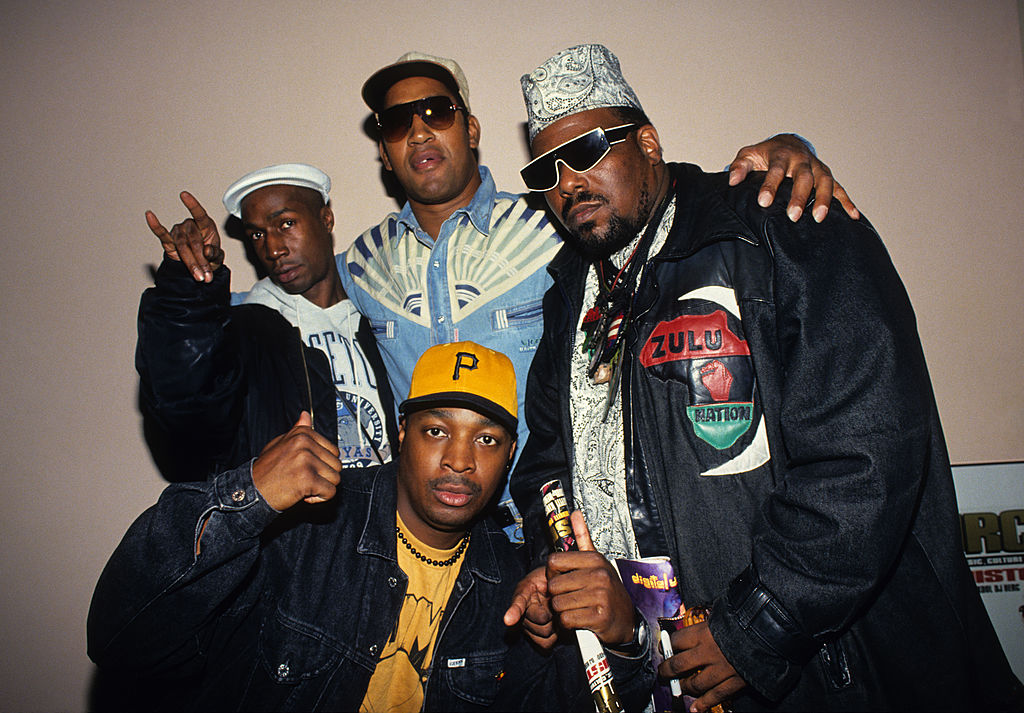
Hip-hop is having a party. For the uninitiated, 2023 marks a year-long 50th birthday celebration for the genre. Celebrations and commemorations abound just about everywhere—even at unlikely places, like the Vice President’s mansion.
This year affords us a unique opportunity to look back on a half-century of development, and to pause and consider the impact of the Black Caribbean artists who democratized broadcast, blended old genres to forge new ones, and, ultimately, helped to lay the foundation for the global phenomenon we know as hip-hop culture.
In the beginning, on Aug. 11, 1973, Clive Campbell—a Jamaican-born DJ better known as Kool Herc—played a back-to-school jam at a West Bronx apartment complex. Behind two turntables and a mic mixer, Kool Herc pioneered a breakbeat-extending technique he dubbed the “merry-go-round.” His sister, Cindy, responsible for organizing the storied rec-room party, in turn became hip-hop’s first promoter. It’s a party that has become legendary, effectively spawning one of the greatest cultural forces of the modern era.
Read More: How Rap Became the Sound of the Mainstream
In its infancy, hip-hop had no label. It was a product of DJs looping soul, funk, and disco—a new method of using percussive R&B music to entertain in an era of sweeping social changes. DJ Kool Herc mixed break-heavy favorites from James Brown to the Incredible Bongo Band, and with his hulking sound system and arsenal of funk and soul records, he brought a kind of people’s choice entertainment to New York’s uptown communities.
Herc soon emerged as a pioneer of New York City hip-hop culture. In 1977, while hip-hop was still a mostly underground phenomenon, this titan of sound eventually squared off in a legendary battle at the Executive Playhouse. Herc and his West Bronx crew, along with other intrepid DJs offering up looped breaks and party vibes, eventually became the center of gravity for young people of color in 1970s New York. Among new innovators were Kool DJ Red Alert, Grandmaster Flash, and Afrika Bambaataa—all of them, like Herc, of Caribbean descent.
The Caribbean connection is critical to this history because it accounts for the competitive spirit, DIY inventiveness, and public spectacle of mobile jockey culture. These DJs, the stars of their neighborhood party scenes, relied on others—the MCs—to hype the crowd and boast about the supreme skills of the artist on the turntables. That relationship between the DJ and his MC derived from a Jamaican “toasting” tradition and its related “sound clash” culture.
More From TIME
Long before hip-hop’s inaugural moment in the Bronx in 1973, sound clashing was a central fixture in the inner-city neighborhoods of Kingston, Jamaica. By the mid-1950s, the formation of competing local DJ crews, or “sound systems,” generally included at least one record selector, MC, and sound tech operating a rig of amps, speakers, mics, turntables, and records. Youth from the community served as the system operators’ foot soldiers of hype and braggadocio in the heat of the clash.
Some of these youths were products of Jamaica’s new extractive industries and land appropriations, which hastened the steady displacement of people from the rural hillsides, pushing migrants to the capital city in search of work and opportunities. Many, like Herc’s own family, along with many of reggae music’s first generation, settled into new affordable urban housing projects in the West Kingston area, near downtown markets. From these communities and their collective efforts to rebuild lives grew a sense of empowerment that fueled the competitive nature of Jamaica’s clash culture.
In the early days of Jamaican sound clashing, DJ crews battled for supremacy over “turf”—small retail stores, public housing projects, or “government yards” where the public congregated. Traditionally, clashes—that is, competitions renown among partygoers—involved two or more sound systems. Each aspired to spin the best record selections in order to win the crowd’s approval and become a reigning champion sound. Like hip-hop rivalries to come, friendly clash competitions could devolve into deadly violence. But, more often, clashes were improvised celebrations of dance and opportunities for poor communities to claim public space for themselves.
Kingston’s earliest sound system operators—renowned originators like Tom the Great Sabastian and Sir Nick the Champ—mixed American R&B, soul, and jazz with emerging popular Jamaican music like mento and ska to sensational effect, not unlike the ways New York’s DJs would blend many genres together to entertain b-boys and b-girls.
Read More: Why the Caribbean Has the Most Energized Anti-Monarchy Movements
At the moment of Jamaica’s independence from Great Britain in 1962, sound systems were slowly becoming features of a widening Jamaican diaspora, with the cultural phenomenon reaching East London and, eventually, New York City. Important waves of Jamaican immigration to the U.S. and England continued mostly unabated during this period—a product of the fact that migrants could circumvent America’s otherwise strict barriers by claiming British citizenship, a legacy of British colonization. While cane-cutting Jamaican migrants tended to toil in the seasonal labors of the American South, most permanent newcomers went to urban centers, settling in the established immigrant havens of New York City and the surrounding tri-state area. Immigrants—among them Kool Herc’s family—brought their folk cultures and sound system traditions with them.
From the beginning, Herc understood that recorded music could be manipulated and transformed dramatically with the use of playback technology—an effort to stand out as a party entertainer inspired by the flair of Jamaican sound system.
While Herc considered his techniques distinct from his Jamaican origins—favoring hard funk over reggae ‘riddims’—he was inspired by the booming and in-your-face systems he once knew in his Trenchtown neighborhood of West Kingston.
Making a name for himself in the Bronx just a few years after his family arrived in the United States, he distinguished himself by replicating Kingston’s original sound system pioneers in the way he shaped his own mobile jockey enterprise. Wiring a McIntosh stereo power amplifier to a pair of six-foot speaker towers he dubbed the Herculoids, Herc fashioned one of the most thunderous sound systems in 1970s New York City.
Born Joseph Richard Sadler, DJ Grandmaster Flash and his family immigrated from Barbados to the Bronx in the early 1960s, alongside a new generation of Caribbean immigrants making their way to the New York metropolitan area. As a technical pioneer, he’d become an early innovator of the genre. One of Flash’s first sound systems, dubbed the Gladiator, was, in fact, built by a veteran Jamaican sound system technician residing in the Bronx.
As Flash was innovating his signature “quick mix” style on the turntables, new Caribbean-American DJs such as Afrika Bambaataa and Kool DJ Red Alert, among others, were creating the framework for the Universal Zulu Nation—a Black Power-inspired youth society for Bronx hip-hop culture. Collectively, these artists helped blend Caribbean music traditions with funk-era “rapping,” the poetry of the Black Arts Movement, and other Black and Latino vernacular traditions, to become the foundation of a new rap genre.
Read More:The Day Hip-Hop Changed Forever
Following hip-hop’s first decade, a burgeoning generation of DJs continued to build upon these traditions, introducing turntablism and live production. What began as a mission to win over the neighborhood, in the tradition of the Jamaican champion sound systems, became something else. By the 1980s, hip-hop DJs no longer just “rocked parties”; they forged rap’s foundation and set the stage for the rise of the MC. The subtle art of turntable mixology transformed disc jockeys from creative spinners and record broadcasters to the creators of new and original music as beat producers and scratch artists.

Despite hip-hop’s vast changes, the Jamaican tradition endures as DJ and MC competitions continue to canonize old- and new-school icons of the genre. Though hip-hop is an American-born genre, built on a foundation of African-American music and culture, hip-hop’s roots are also tied to immigrant histories and diasporic cultures. Perhaps that reminds us how rich and textured the culture truly is.
Alex La Rotta is a professor of history at Houston Community College, specializing in U.S. Latino, social, and music history. Made by History takes readers beyond the headlines with articles written and edited by professional historians. Learn more about Made by History at TIME here.
More Must-Reads from TIME
- Why Biden Dropped Out
- Ukraine’s Plan to Survive Trump
- The Rise of a New Kind of Parenting Guru
- The Chaos and Commotion of the RNC in Photos
- Why We All Have a Stake in Twisters’ Success
- 8 Eating Habits That Actually Improve Your Sleep
- Welcome to the Noah Lyles Olympics
- Get Our Paris Olympics Newsletter in Your Inbox
Write to Alex La Rotta / Made by History at madebyhistory@time.com
